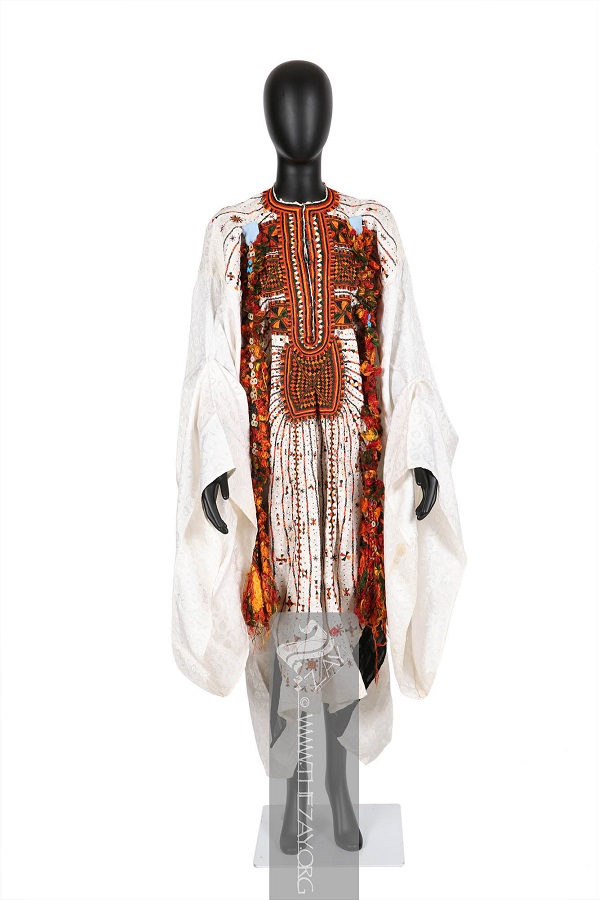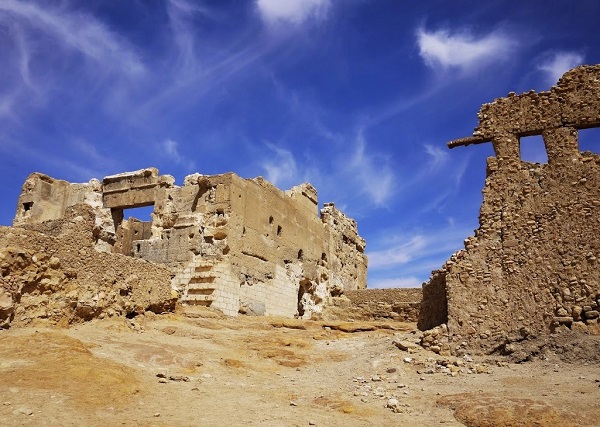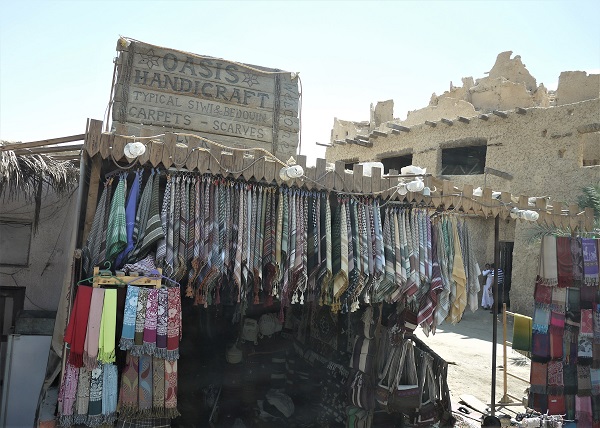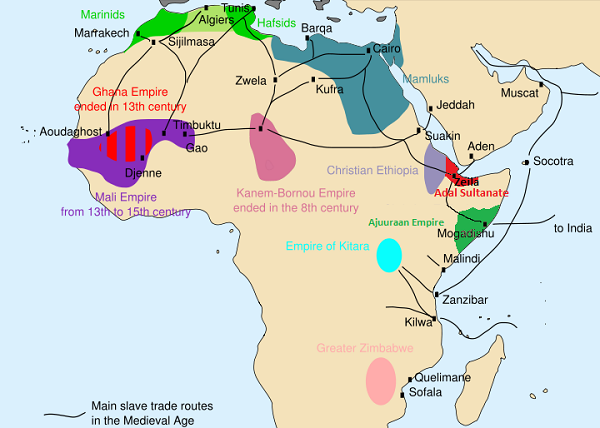Colorful Heavily Embroidered Clothes in Fashion
This is Part 2 in a series on the wearing apparel and beautification from t he Siwa O asis, an isolated settlement in Egypt, shut to the Libyan border at the edge of the Western Desert . Inhabited past sedentary descendants of the nomadic Amazigh, or Berbers, Siwa is the only pocket of Amazigh so far east in North Africa , all other nomadic people in Egypt are Bedouin. The people and traditions of the Siwa Oasis are often linked more to those of North Africa rather than to Egypt. The series is inspired by these items in the Zay Initiative's Collection: a heavily embroidered traditional bridal tunic, called asherah nuhuwak (ZI500491 Arab republic of egypt), and two coloured woollen braids, chosen legateen or liquatin (ZI500491a Egypt), that are detachable decoration for the bridal costume. Read Part 1 here.

Asherah nuhuwak in The Zay Collection Photo: The Zay Collection
The history of Siwa'south international influence and exchange
Due to the isolated location of the Siwa Haven, the customs of the inhabitants take remained separate from the main Egyptian culture for centuries. They were not fully integrated into modern Egypt until a road connecting them to the Mediterranean coast at Marsa Matruh was paved in the 1980s. At that time, efforts were made to digest the Siwans into the greater Egyptian culture, and Arabic became the official language. Yet, a distinct Siwan identity remains strong and Siwi, a Tamazight (Berber) tongue, is nonetheless spoken today.
Regardless of the isolated location, the oasis has not been allowed from outside influence. Since ancient times, Siwa was an important terminate on the trade routes and outsiders have been drawn to the oasis since antiquity. Maybe the most famous of its notable visitors was Alexander the Bully. In 332/331 BCE he journeyed over the desert with the specific purpose to visit the Oracle Temple of Amun-Ra and was allegedly informed by the Oracle that he was indeed the son of Amun, the Pharaonic god associated with the Roman god Zeus. It is oft speculated that Alexander the Bully's final resting place is in Siwa.

The Oracle Temple of Amun-Ra. Photo by the author (2014)
Under the British occupation of Egypt (1882-1922), Siwa was a popular tourist attraction for the colonialists. They would travel via rail and coach for a nine-day tour, or via a camel safari that would take a month. After World State of war Ii, tourism stopped, equally access to the haven was restricted. In that time efforts were made to politically incorporate Siwa into mod Egypt, merely it was non until the asphalt road was completed in 1984 that restrictions were lifted and once over again tourism and travel returned to the Haven.

One of many tourist shops in Siwa Town Photo by the author (2014)
The cardinal location forth the trade routes stretching from S East Asia across the African continent meant that cultures and traditions were both brought to and carried from the trading mail service. Indeed, in that location are even inhabitants of sub-Saharan African origin, who were brought to Siwa during the slave trafficking days when Siwa was 1 of the markets along the trans-Saharan slave route through Kufra in Libya. Thus, the unique civilization of Siwa was not created in a vacuum. North African nomads, descendants of Sub-Saharan slaves, traders, and tourists from artifact to modern-mean solar day, have all had some impact on what we know every bit the traditional Siwan culture.

Slave trade routes Photo: Wikimedia Commons
While Siwan jewellery and dress are quite unlike from anywhere else in Egypt, including the other oases of the Western Desert, it is oft reminiscent of that seen in Tunisia, Morocco, Libya, and (somewhat surprisingly) Yemen.

Yemeni T-shaped tunic clothes from The Zay Drove Photograph: The Zay Drove
Afterwards examining some of the items from Yemen in the Zay Initiative'southward Collection, it is clear that the T-shape of the Siwan tunic bears striking resemblances to some of the dresses from Yemen. In contrast, about Egyptian garments in recent history, both from other oases and along the Nile valley, are typically A-line with narrow sleeves. Yet, every bit Sharira Mehrez discussed in her contempo webinar, the wide T-shape institute in Siwa is traditional to Egypt, dating back to Pharaonic times. It was not until the 19th Century that the narrow A-line shape was adopted throughout well-nigh of Egypt due to Western influences.

Mutual woman's dress from the 18th century as found in Clarification de L'Egypte Photo: via Shahira Mehrez'south webinar
Information technology is unclear where exactly the T-shape first originated, just merchandise routes spread non only ideas and values around the world, simply also adornments and artefacts. The employ of cowrie shells and nacre buttons in Siwan adornment is another example of the distribution of items across merchandise routes. Siwa's prominent location linking the declension to the desert interior has resulted in a unique culture that both influenced and was influenced by the exterior world.
Influenced influences: Fashion in the globalised globe
From my personal experience living in Cairo and regularly shopping for clothing and handicrafts in both tourist shops and boutiques aimed towards Cairenes, I would fence that the traditional (and not so traditional) embroidery from Siwa is one of the most distinctive and popular styles represented in Arab republic of egypt. Siwan traditional embroidery is highly recognisable and has become fashionable to adorn modern clothing in Cairo, with brands like Jozee Boutique and Nevin Altmann, and even abroad.

Modern habiliment with Siwan embroidery Photo: www.jozeeboutique.com
Originally, the inflow of machine-made appurtenances to the oasis led to a decline in the production of traditional handicrafts, but with the increment in the tourist industry Siwans one time again began to produce goods specifically to sell to the visitors. In the early 2000s, Egyptian entrepreneur Laila Neamatallah opened an atelier located in the Siwa Oasis, named 'Siwa Creations,' to help Siwan women and girls sell their embroideries and earn an independent income. Over the years, the company has hired hundreds of Siwan woman to run up their traditional embroidery for exclusive haute couture designers in Europe, such as the Italian fashion houses of Ermanno Scervino and Nia Ferrante. The demands of the international mode industry accept influenced both the motifs and the colours used in Siwan embroidery. Neamatallah, the founder of 'Siwa Creations' states that,
"[t]raditionally Siwa women use merely five bones colours: red, green, blackness, orange and yellow, which remind them of the dates and olives Siwa has been famous for throughout history. I brought in new colours. We dye our yarn and create our own colours. I follow way trends very closely, so we are able to create a highly fashionable paw-made production inspired by Siwan traditional embroidery." (Laila Neamatallah, Arab News, 6th July 2006, quoted past TRC Leiden)

Siwan embroidery used for Italian haute couture Photo: TRC Leiden
The company has empowered women past providing them with autonomous income. Most of the women who work in these factories are young and unmarried, and the increase in their wealth has the potential to atomic number 82 to better union prospects or their independence if they so wish. Even so in that location has also been criticised for such projects which are seen every bit changing traditional handicrafts to meet the needs of the Western manner industry. In this mode, there are both pros and cons to the popularity of Siwan traditional embroidery.
More problematic is a contempo case with Parisian fashion business firm Chloé. In 2016, British vocalizer Adele wore a Chloé dress during her performance at the Glastonbury Festival. This black, heavily embellished wearing apparel appears to be inspired by the traditional embroidery and beadwork of Siwa. The manner house described the dress every bit inspired past the 1970s, taking over 200 hours to complete. Their statement caused some controversy in Arab republic of egypt past non mentioning that it was a copy of the traditional black Siwan wedding dress, chosen asherah hawak azdhaf, equally was widely believed by Egyptians. The dress wowed Western audiences and in one case again, during quarantine in 2020, Adele donned her 'Siwan' dress for her fans on Instagram (after a few ciders, as she claimed).

Adele at Glastonbury 2016 Photo: BBC / Adele at home 2020 Photograph: Instagram
Does the side by side expect from Chloe's autumn 2016/2017 runway look familiar? The fashion firm described this dress equally an original design. Siwa was never mentioned as a place of inspiration and these pieces were not embroidered past the Siwans themselves.

Chloé Autumn 2016/2017 runway show Photo: Pinterest and Canva
This opens all sorts of discussions on cultural cribbing which we will not go into at this fourth dimension for the sake of brevity. Nonetheless I volition state that I feel there is a huge difference betwixt what companies such equally Jozee Botique, Nevin Altmann, and Siwa Creations (in collaboration with Italian fashion houses) are doing as opposed to the deportment of Chloé fashion house. By the former employing local Siwan women and accrediting the designs to the traditional culture in which they were created, there is transparent appreciation leading to a level of empowerment, versus the clear appropriation of the latter. There is certainly room for farther discussion on this topic.
Changes in the wedding ceremony ceremony
Equally the asherah nuauk in the Zay Initiative'due south Collection that initiated this discussion, is a white bridal dress, nosotros cannot cease this blog post without mentioning the changes in the Siwan nuptials ceremony that came forth with modernisation.
Before the 1980s, and as recently as the early 2000s, Siwan brides wore seven different nuptials costumes during the elaborate calendar week-long celebration. The white dress was but worn on 1 of these days, the other dresses were black, green, red, and striped. Yet with the desire for modernity and with the influence of Western civilization, white wedding dresses became the about desired. Instead of importing Western-manner white wedding dresses, nigh modern Siwan brides attempt to blend modernity with tradition. In this manner, the white asherah nuauk has become the most widely worn Siwan hymeneals costume. Brides now have a much more modest trousseau than before (see blog mail service #i), and indeed the ceremony itself is no longer a week long. The bride's outfits are usually limited to one asherah nuauk, a pair of embroidered srawelin khatem trousers, and one or two embellished troket headscarves. In comparison, not and then long agone, a Siwan helpmate would take every bit many every bit 30 trokets, forth with the seven unlike coloured dresses.
Siwan women'southward choice for everyday clothing has also changed due to exterior influences in recent years. Many at present choose to habiliment the black Islamic face veil instead of covering with the tarfutet, a large bluish scarf that must be held closed over the face up. In comparison, the niqab is seen equally more than practical every bit it frees the wearer's hands while providing modesty. For everyday clothing effectually the home, only the older generations nonetheless wear the traditional striped T-shaped tunics. Most now prefer the prepare-fabricated gallabiyah that is ubiquitous across Egypt.
It is clear that from artifact, despite the isolated location, the unique culture and traditions of the Siwa Oasis have always been influenced by the exterior world. Yet, in the past, the step of change was slow, whereas now the touch of modernity is rapid. It is important to remember that nothing exists in a vacuum and 1 cannot expect whatever tradition to come without influence. Fifty-fifty the people in a remote desert settlement on the Egyptian and Libyan border can exist 'influenced influencers.'
Function 3 in this series volition explore the connection between Pharaonic Egypt and Siwan adornment.
Further Reading – Print:
- Fahmy, Azza 2007. Enchanted Jewelry of Egypt. American University in Cairo Printing, Egypt.
- Fakhry, Ahmed. 1973. The Oases of Arab republic of egypt, book one: Siwa Oasis. American Academy in Cairo Press, Egypt.
- Malim, Fathi 2001. Siwa: from the inside. Traditions, customs, & magic. Al Kaatan, Egypt.
- Qurashi, Wafaa Abd Elradi 2020. "An Innovative vision for re-designing traditional Siwa clothes," International Design Periodical: Vol. 10.four.
- Vale, Margaret 2015. Siwa: Jewelry, Costume, and life in an Egyptian oasis. American University in Cairo Printing, Arab republic of egypt.
- Vivian, Cassandra 2000. The Western Desert of Egypt. American Academy in Cairo Press, Egypt.
Further Reading – Online:
- http://news.bbc.co.uk/1/hi/world/middle_east/3758950.stm
- https://world wide web.trc-leiden.nl/trc-needles/organisations-and-movements/ngos-and-self-assistance-groups/siwa-creations
- https://english language.ahram.org.eg/NewsContent/7/47/232330/Life–Style/Style/Adeles-dress-past-Chloe-sparks-Siwa-comparisons-on-south.aspx
- https://madame.lefigaro.fr/defiles/chloe/automne-hiver-2016-2017/pret-a-porter-0/113155
0 Response to "Colorful Heavily Embroidered Clothes in Fashion"
Post a Comment